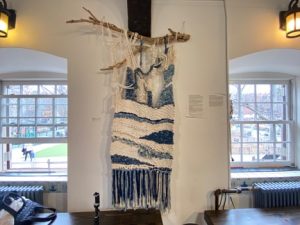
BY KAYLIN GUZMAN
BROOKLYN – Textile artist breaks the norms of fine art at the Old Stone House in Brooklyn. Since October 2022, the Belonging exhibit has prompted conversations about the complexities of this fine art category and has been on display for Brooklynites to enjoy for free.
The exhibit closed on Sunday, Feb. 13, with an engaging discussion with the curator and artists.
The exhibition showcased diverse, hand-crafted art from three female artists in New York City. Each creator had a unique story that led them to pursue textile art.
Dr. Grace Freedman, a founder of Why Not Art, collaborated with the Old Stone House to unite the diverse group.
“The Old Stone house likes to have contemporary shows that are connected to some community aspect,” Freedman explained.
She said that different related events made this exhibit right for the surrounding community. Events such as the Kings County Fiber Festival and 4 Ave Yarm Bomb prompted Freedman and contemporary curator Katherine Gressel from the Old Stone House to bring this exhibit together.
Freedman included art from Stephanie Eche, Traci Johnson, and long-time friend Kimberly Bush. Each artist chose art to express their stories and collective experiences with textile arts.
“I was looking to have a diverse group of women and defined artists because I feel that there is that strong sense of textiles being women’s work. Can it be fine art?” asked Freedman.
An audience member from the panel pondered the same question. “Is textile art considered to be fine art?”

“This art has not sold,” Eche informed her audience. “So, is it taken seriously as fine art, you know? I don’t define that as success myself, but I would also not like it to live in my home or storage for the next twenty years.”
Eche focuses on using sustainable art practices through organic materials and incorporating discarded art into her new pieces. She explained many of the students she teaches leave textile crafts in her possession, which later prompts her to give them purpose in new ways.
“A lot of the actual knots, the macrame knots, are from a lot of the workshops that I lead pre-covid,” said Eche.
She explained that her Mexican ancestral ties with textile art led her to pursue this form of fine art.
“I never understood my obsession with textiles, but I found a family story that could be a legend, could be not. That my great-grandpa, when he came over … over, there was no border,” Eche remarked.
She explained that with his sister, her great-grandfather opted to be smuggled into the United States instead of risking their clothes.
“That really touched me because I think we forget about our clothes and we forget about how important they should be. We used to weave them out of nothing,” Eche said.
Her family’s connection to Mexican culture influences much of her art. Although misconstrued, she wants to highlight the hidden parts of Mexico’s reputation.
“I went to Mexico City for the first time, probably like seven years ago. And like being Mexican, and I feel like my whole life being told that Mexico is a scary place and that we don’t go there and stuff. And then going to Mexico and being like, holy shit, no one told me about this,” said Eche.
With inspiration from textile artists from Mexico and the nature around her, Eche’s goal is to spread awareness of textile art and the artisans behind it. With the conclusion of Why Not Art’s Belonging exhibition, textile art has entered the fine arts conversation.

